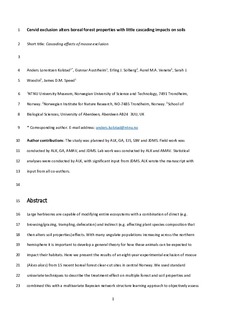| dc.contributor.author | Kolstad, Anders Lorentzen | |
| dc.contributor.author | Speed, James David Mervyn | |
| dc.contributor.author | Austrheim, Gunnar | |
| dc.contributor.author | Solberg, Erling Johan | |
| dc.contributor.author | Woodin, Sarah J. | |
| dc.contributor.author | Venete, Aurel M A | |
| dc.date.accessioned | 2017-11-14T15:59:36Z | |
| dc.date.available | 2017-11-14T15:59:36Z | |
| dc.date.created | 2017-11-14T11:39:52Z | |
| dc.date.issued | 2017 | |
| dc.identifier.issn | 1432-9840 | |
| dc.identifier.uri | http://hdl.handle.net/11250/2466283 | |
| dc.description.abstract | Large herbivores are capable of modifying entire ecosystems with a combination of direct (for example browsing/grazing, trampling, defecation) and indirect (for example affecting plant species composition that then alters soil properties) effects. With many ungulate populations increasing across the northern hemisphere it is important to develop a general theory for how these animals can be expected to impact their habitats. Here we present the results of an 8-year experimental exclusion of moose (Alces alces) from 15 recent boreal forest clear-cut sites in Central Norway. We used standard univariate techniques to describe the treatment effect on multiple forest and soil properties and combined this with a multivariate Bayesian network structure learning approach to objectively assess the potential mechanistic pathways for indirect effects on soils and soil fertility. We found that excluding moose had predictable direct effects, such as increasing the ratio of deciduous to coniferous tree biomass and the canopy cover and decreasing soil bulk density and temperature. However, we found no treatment effects on any measures of soil processes or quality (decomposition, nitrogen availability, C/N ratio, pH, nutrient stocks), and furthermore, we found only limited evidence that the direct effects had cascading (indirect) effects on soils. These findings oppose the commonly held belief that moose exclusion will increase soil fertility, but still highlights the strong ability of moose to directly modify forested ecosystems. | nb_NO |
| dc.language.iso | eng | nb_NO |
| dc.publisher | Springer Verlag | nb_NO |
| dc.title | Cervid Exclusion Alters Boreal Forest Properties with Little Cascading Impacts on Soils | nb_NO |
| dc.type | Journal article | nb_NO |
| dc.type | Peer reviewed | nb_NO |
| dc.description.version | acceptedVersion | nb_NO |
| dc.source.journal | Ecosystems (New York. Print) | nb_NO |
| dc.identifier.doi | 10.1007/s10021-017-0202-4 | |
| dc.identifier.cristin | 1513878 | |
| dc.description.localcode | © Springer Verlag. This is the authors' accepted and refereed manuscript to the article. LOCKED until 13.11.2018 due to copyright restrictions. The final publication is available at https://link.springer.com/article/10.1007%2Fs10021-017-0202-4 | nb_NO |
| cristin.unitcode | 194,31,10,0 | |
| cristin.unitname | Institutt for naturhistorie | |
| cristin.ispublished | true | |
| cristin.fulltext | postprint | |
| cristin.qualitycode | 2 | |
